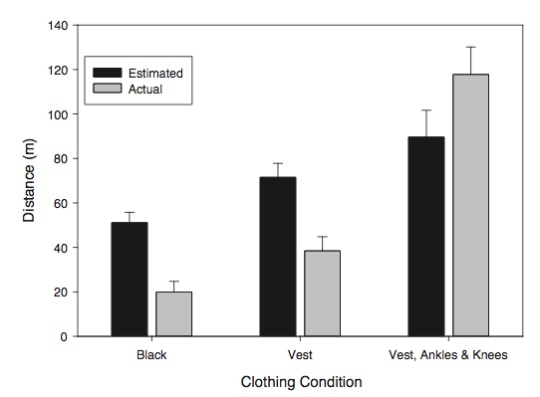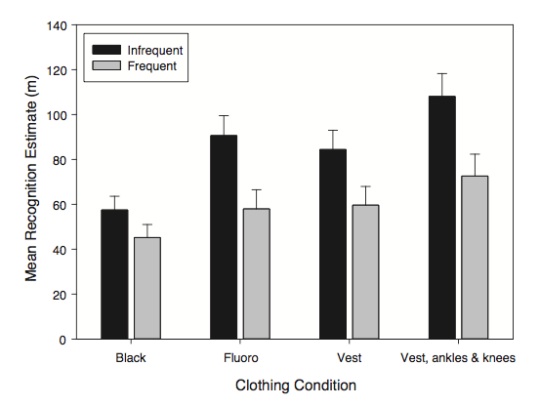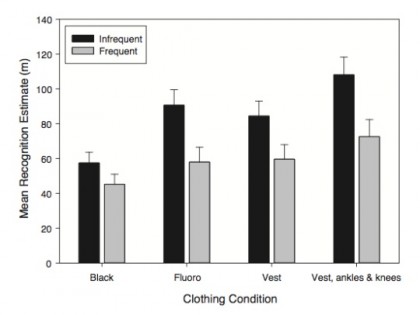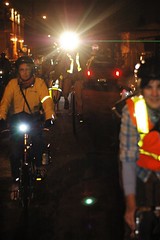People who ride bikes at night consistently overestimate their visibility to other road users, a new study has found.
They also overlook a few tricks, like reflective strips around the ankles and knees, that can help the most.
The report, led by Joanne Wood of the Queensland University of Technology in Australia and published in next month’s issue of Accident Analysis & Prevention, asked both regular and occasional bike riders wearing black clothing, fluorescent or reflective vests, and vests with reflective strips to estimate the point at which an approaching driver would be able to spot them. Different lighting setups were used, too.
People wearing black clothing on their bike at night, or just a reflective vest, were far too optimistic. They thought drivers would see them from nearly twice the distance drivers actually tend to.
Meanwhile, riders correctly estimated that they were more visible to other road users when wearing retroreflective strips on their knees and ankles. But the strips are actually more effective than people thought.
To see how people’s ideas measure up with reality, check out the chart below. The black bars indicate the distance at which people riding bikes thought they would be spotted in each type of clothing, and the grey bars indicate actual visibility:

These figures included tests with three different types of lighting on the bikes: a flashing light, a steady light and no light.
“The bicyclist’s overestimates are greatest for conditions in which actual conspicuity is minimal and they underestimate the effectiveness of vest plus ankles and knees,” Wood’s report summarized. “This study provides the first quantitative data to support the suggestion that bicyclists overestimate their own conspicuity to drivers at night.”
Here’s another important finding: if you bike more often, you tend to get a better sense of just how invisible you can be at night:

“Less frequent bicyclists rated themselves as visible at longer distances (M = 85.19 m) than did frequent bicyclists (M = 58.89 m),” the study found.
A couple other interesting notes:
- At night, reflective vests are much more effective than fluorescent ones. Bright orange or yellow vests are great for catching people’s attention during the day. But many of us don’t realize they’re not much use at night. “Fluorescent materials have little conspicuity benefit at night since they are activated only by ultraviolet radiation (which is generally not present in headlights and streetlights). The bicyclists … appear to believe, incorrectly, that the conspicuity advantage of fluorescent materials is as useful at night as it is in daylight. Thus bicyclists, who habitually wear fluorescent as opposed to retroreflective materials, may dangerously overestimate their conspicuity at night.”
- Riders think flashing lights increase visibility. Though the data is less conclusive about whether steady or flashing lights are better, this study found that people think flashing bike lights are the most visible.
- Reflective strips have to be moving to do much good. “It is only when those retroreflective strips are mounted on the moveable joints that they substantially increase bicyclist conspicuity,” the study wrote. Why don’t people tend to realize this? The authors have an idea: “from a bicyclist’s perspective, retroreflective material does not necessarily appear to be particularlyvisible. It is only when the retroreflective material is viewed under specific viewing conditions (e.g., moving in a characteristic pattern, illuminated by the vehicle’s headlights, and viewed from a position proximal to the headlights) that its effectiveness becomes clear.”
Obviously, keeping everyone safe on our streets at night is a joint effort that requires vigilance and caution by everyone who’s getting around. Fortunately, Portland has enough bikes on the street that it makes those of us who use cars more careful when we’re driving at night. But this study is a great reminder that our intuition about these issues isn’t always right – it helps to know the facts, too.
— Portland Afoot editor Michael Andersen will be contributing regularly to BikePortland for the next few weeks as we start working out more details of the collaboration announced earlier this month.


